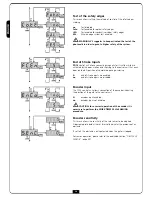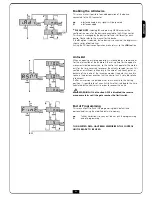
ENGLISH
36
SAFETY RIBBONS
The control unit considers two kinds of safety ribbons,
depending on the terminal to which they are connected:
•
Type 1 (fixed):
they are mounted on walls or on other fixed
obstacles that are approached by the gate doors during the
opening phase. When type 1 safety ribbons operate during
the gate opening phase, the control unit will close the doors
for 3 seconds, then it stands still; when type 1 safety ribbons
operate during the gate closing phase, the control unit will
stand still immediately. The direction of the gate at next
command of START or PEDESTRIAN START depends upon the
parameter STOP (it inverts or continues the motion).
If the input STOP is disabled, the command makes the motion
continue in the same direction.
•
Type 2 (mobile):
they are mounted to the door ends.
When type 2 safety ribbons operate during the gate opening
phase, the control unit will stand still immediately; when
type 2 safety ribbons operate during the gate closing, the
control unit will open the doors for 3 seconds, then it will
stand still. The direction of the gate at next command of
START or PEDESTRIAN START depends upon the parameter
STOP (it inverts or continues the motion). If the input STOP
is disabled, the command makes the motion continue in the
same direction.
Both the input can manage the classic safety edge with n.c.
contact and the conductive rubber safety edge with 8,2 kohm
nominal resistance.
In addition, the V2 wireless edge system may be managed (see
the instructions provided with the device).
Connect type 1 safety ribbons cables between terminals
P9
and
P11
of the control unit.
Connect type 2 safety ribbons cables between terminals
P10
and
P11
of the control unit.
In order to meet the requirements of the EN12978 rules, it is
necessary to install safety edges controlled by a control unit
continuously checking the proper working. If using control units
suited to the test by power outage, connect the power supply
cables of the control unit between terminals
P13
and
P14
of the
control unit.
Otherwise, connect them between terminals
P12
and
P13
.
m
WARNING:
• Make use of safety ribbons having outputs with normally
close contact.
• Outputs of same kind safety ribbons must be connected in
series.
PHOTOCELLS
The control unit considers two kinds of photocells, depending on
the terminal to which they are connected:
•
Photocell 1:
that is to say, photocells installed on the gate
inner side, which are active both during the opening and the
closing phase. When photocells 1 operate, the control unit
stops the gate; as soon as the photocell beam is free, the
control unit will open the gate completely.
m
WARNING:
Type 1 photocells must be installed so that
they completely cover the opening area of the gate.
•
Photocell 2:
that is to say, photocells installed on the
external gate side and which are active during the closing
phase only. When photocells 2 operate, the control unit
opens the gate immediately, without waiting for release.
PD18
control unit supplies a 24VAC power supply to photocells
and it can perform a photocell operation test before starting the
gate opening phase. Photocell power terminals are protected by
an electronic fuse that stops current in case of overload.
• Connect power supply cables of photocells transmitter
between terminals
P13
and
P14
of the control unit.
• Connect power supply cables of photocells receiver
between terminals
P12
and
P13
of the control unit.
• Connect receiver output of photocells 1 between terminals
P7
and
P11
of the control unit and receiver output of photocells
2 between terminals
P8
and
P11
of the control unit.
Use outputs having normally closed contact.
m
WARNING:
• if several couples of same kind photocells are mounted,
their outputs must be connected in series.
• In case of reflection photocells, power supply must be
connected to terminals
P13
and
P14
of the control unit to
carry out the operation test.
Summary of Contents for FORTECO
Page 2: ......











































